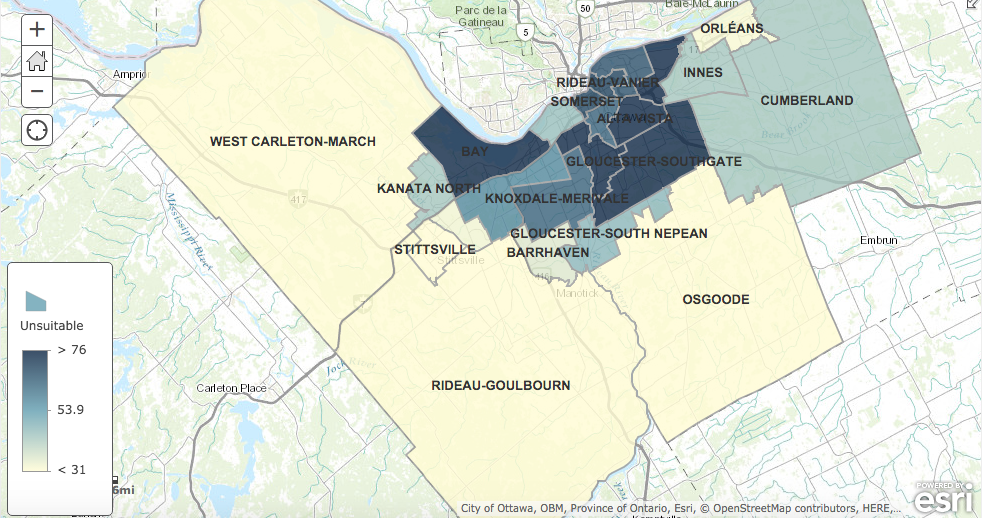By: Craig Lord
Ottawa is falling short of expectations when it comes to providing suitable and affordable housing for its lowest-income citizens, experts say.
According to the 2011 National Household Survey, the five wards with the lowest median income are also among the six wards with highest instances of unsuitable housing per 1000 households. In other words, the lowest income residents are also most likely to experience unsuitable housing conditions.
Number of Unsuitable Homes per 1000 Homes, by Ward in Ottawa:

For a residence to be classified as unsuitable, according to Statistics Canada, means that the dwelling has enough bedrooms to fit the family living in it. Unsuitable homes may have children, parents, or even grandparents sharing bedrooms on a permanent basis.
“For a certain subset of the population, there’s a real difficulty in being able to find something that meets their needs,” says Noah Zon, a project lead with the Mowat Centre. Zon wrote a report in May of 2015 outlining Canada’s needs when it comes to affordable housing.
“There hasn’t been a lot of investment in new, purpose-built, rental buildings in Canada,” Zon says.
In September 2013, Ottawa city council embarked on a ten-year plan for housing in the Capital. It included approval for 130 new affordable housing units from 2013 to 2015 through the Ontario provincial Investing in Affordable Housing (IAH) Program. Affordable housing are units owned or subsidized by the city which offer rent reduced from market price for tenants, usually tied a household’s lower income.
Construction of additional units past 2015 has yet to be established, but that’s not the main concern for Steve Pomeroy, an urban planning consultant and associated researcher at Carleton University’s Centre for Urban Research and Education (CURE).
“There has been a preoccupation with ‘we need to be building affordable housing,’” Pomeroy says, noting that building affordable housing units is an expensive operation in itself.
In assessing the city’s response to its residents’ housing needs in recent years, Pomeroy offers a grade of “C+” – less than satisfactory.
“I think that it can spend smarter,” he says. Pomeroy suggests more direct support to lower-income families to facilitate renting affordable houses.
Just how big is the need for affordable options in Ottawa? In 2006, the Canada Mortgage and Housing Corporation (CMHC), a crown corporation tasked with housing issues in the country, said that 40,760 households were in “core housing need.”
Core housing need is composed of three metrics: whether a house is in adequate repair, whether a house is suitable (proper capacity for the household), and whether it’s affordable for the household. Affordability is determined by whether or not a household is putting more than 30 per cent of its income before taxes into housing payments.
The CMHC has not released numbers for 2011, given that variation between the National Household Survey and long-form census make comparisons difficult.
According to a report prepared before the establishment of Ottawa’s ten-year plan, at the start of 2013, 9,717 households were on a waiting list for a spot in Ottawa’s social housing.
Housing Needs in Ottawa, an Overview – City of Ottawa
Zon says that families waiting for suitable housing are subjected to difficult living conditions. “When a household is either in inadequate, or unsafe, or they’re spending a significant amount of their income on shelter, it has widespread impacts on other aspects of their lives,” he says, noting that inadequate housing can affect healthcare outcomes and children’s schoolwork. “If you’re spending more on your housing, you can’t invest as much in your own well-being.” According to Zon’s report on affordable housing across Canada, 1 in 7 households are currently unable to afford adequate housing without spending more than 30 per cent of their income.
Access to Affordable Housing – Mowat Centre






